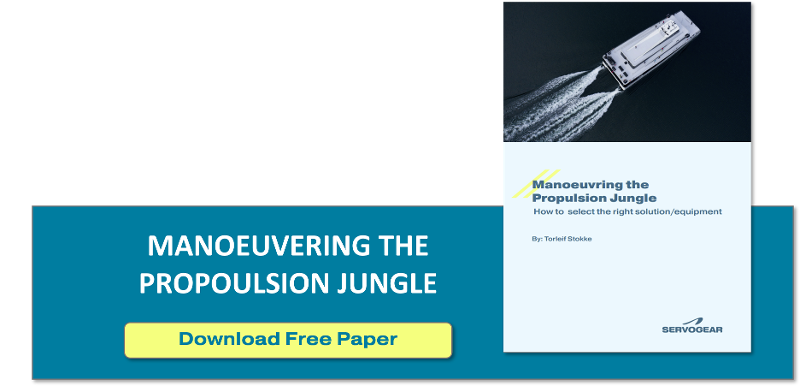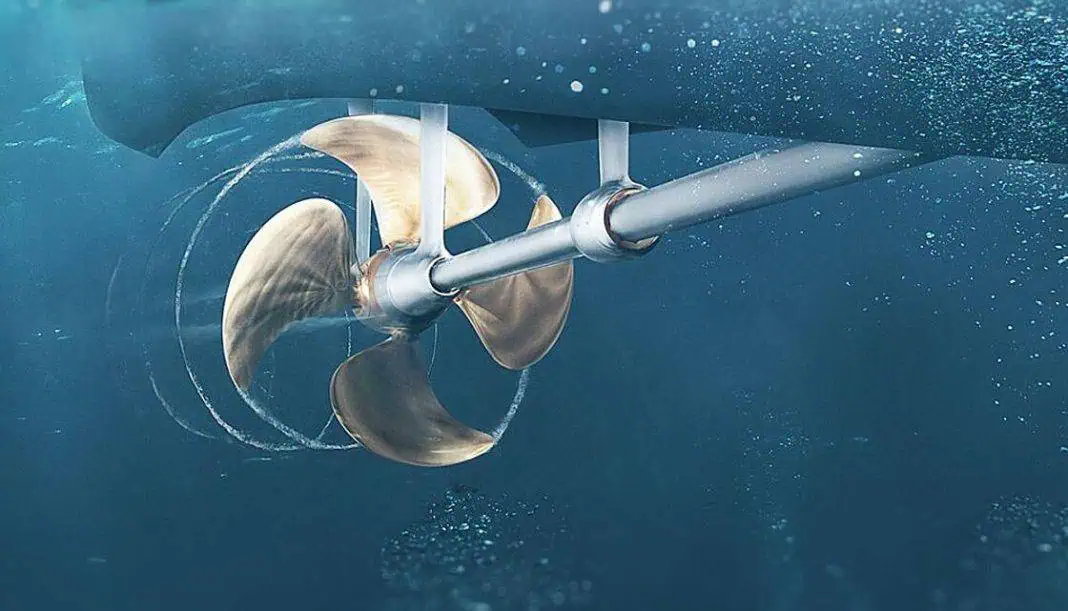Because of its link to the overall performance of the vessel, the propulsion system is doubtlessly an important part of any vessel. The three most frequently used propulsion systems are the Water Jet (WJ), the Fixed Pitch Propeller (FP) and the Controlled Pitch Propeller (CPP).In this article, we will discuss the differences between the WJ and the CPP, take a quick glance at their pros and cons and how choosing the right system can potentially reduce fuel consumption and by that, the cost and emissions as well.
The Water Jet propels vessels by a reaction force, generated by high-speed jetting of the water stream. With this system the propelling force is generated by adding momentum to the water by accelerating a certain flow of water in an astern direction.
The CPP has a fixed diameter of the blades adapted to the vessel, however at a changeable pitch. Meaning that the propeller blades can be dynamically adjusted during an operation through turning the angle of attack. Consequently, it can be used to run the vessel in both forward and astern direction, without having to change the rotational direction of the shaft.
COST AND ENVIRONMENT
When selecting a propulsion system for your vessel, it is important to consider the different variables or characteristics that are important to your means of operation. Both the Water Jet and the CPP has great features and advantages, it really just depends on your vessel and its intended use.
Investing in the right propulsion system can heavily influence consumption, environmental impact and the performance of your vessel.
The Water Jet has several characteristics that may affect the fuel cost negatively, but also has its advantages:
FUEL CONSUMPTION OF THE WATER JET
- The Water Jet can be up to 30% less effective than a well-designed CPP. Consequently, it requires you to invest in bigger and more expensive engines compared to a CPP to perform similar.
- The efficiency is sensitive to load and weather conditions and is easily reduced when there are waves or wind hitting the vessel.
- The efficiency curve has a steep fall when slowing down the speed (from 50 knots to 20-30 knots) and is very sensitive to the variation of payload. This means that if the payload increases, it negatively affects the speed and efficiency.
- If your means of operation is stable with regards to payload, sailing route and weather conditions, the WJ can be the correct alternative.
- When sailing in shallow water, the WJ will have a clear advantage over propellers. Also, if the route has debris challenges it would be favorable to chose the WJ over classic propulsion.
FUEL CONSUMPTION OF THE CPP
The CPP has several qualities directly affecting its efficiency and fuel consumption:
- The CPP is efficient in a wide speed-range, giving the best overall efficiency, and by this reduced fuel cost and emissions.
- It is flexible to payload variations. Due to its versatility, the vessel is able to obtain a good fuel efficiency (OPEX). The reduced energy consumption enables vessels a lower threshold to use zero emission energy sources.
- The ability to adjust the pitch of the propellers allows for higher efficiency within a range of operational profiles and avoids overload of engines.
- When speaking of hybrid and electric vessels, one can manage with less battery power when comparing CPP to Water Jets. This, in turn, leads to reduction of weight and consumption will naturally decrease.
- Depending on the profile, certain vessel operations will require the use of bollard push or pull. A good example is a wind farm service vessel, which need to push itself against the offshore wind turbine in order to enable personnel to move safely from vessel to turbine. Under different weather and wave conditions, the power and thrust needed can be quite significant to perform such operations in a safe manner. The load on main engine(s) will be significantly lower when using CPP rather than Water Jets for this purpose, leading to lower fuel consumption, less energy needed, and reduced pressure on main engine(s).
CONCLUSION
Today, the Water Jet is market leading in terms of number of vessels in operation. On the other hand, more and more shipowners are exploring the possibility to utilize a CPP system for their vessels.
It is becoming clear that, under many circumstances, the CPP is by far the most efficient, as well as the propulsion type that can make the biggest difference in terms of economy and environment due to its low consumption of fuel compared to the Water Jet.
Bjørn Sturle Hillestad
However, it is important to keep in mind that it’s crucial to regard the propulsion line as a whole when considering the options. A CPP will only work at its best when it is thoroughly designed together with the rudder, brackets and the tunnel.
When investing in a new vessel or converting your current vessel, make sure to do a proper evaluation and get professional measures on potential fuel savings and environmental footprint before making your decision. It is well known that a Water Jet system might be less expensive to install on the vessel, but in the long run the fuel consumption and environmental footprints might be worth paying attention to.













